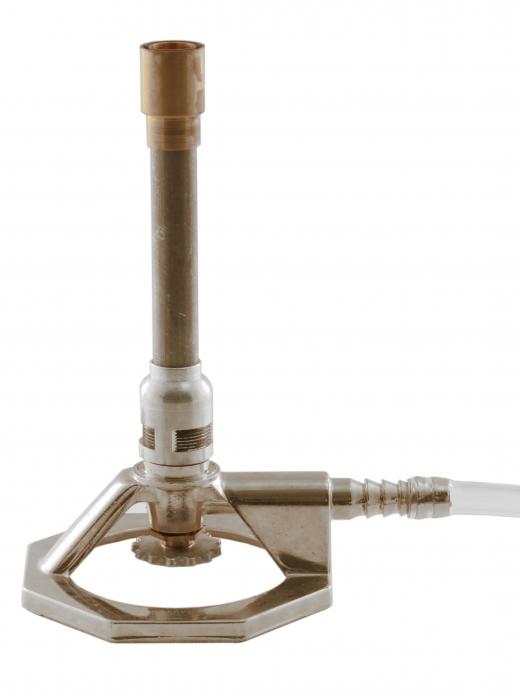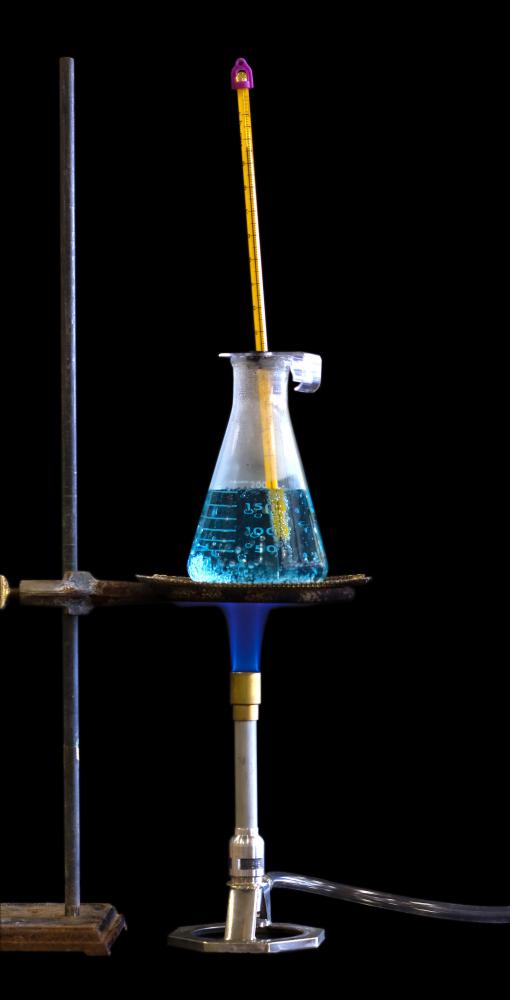What is a Bunsen Burner?
 Mary McMahon
Mary McMahon
A Bunsen burner is a laboratory device used to heat substances for various experiments. In essence, they are small gas burners with an adjustable flame, manipulated at the base by controlling the amount of gas and air admitted. They are a common sight in chemistry laboratories and most scientists are familiar with their operation. For providing moderate heating, especially of liquids in beakers and flasks, an electric hot plate may be preferred, but when high temperatures are needed, or when heating materials in test tubes, a Bunsen burner is required.
Design and Operation

The device consists of a vertical metal tube connected to a broad base that is weighted so that it is not easily knocked over. The base includes a nozzle to connect with a fuel source, as well as a valve to control the flow of gas, and a flue adjuster to control how much air is admitted through one or more small air holes at the base of the tube. The gas mixes with air at the bottom of the tube and then rises to the top of the burner, where it can be lit with a match or lighter.

With the air holes are closed, a yellow, smoky flame is produced, due to incomplete combustion of carbon. Natural gas consists mainly of methane, a carbon-hydrogen compound; if there is insufficient air, not all the carbon combusts, and instead forms tiny soot particles that glow yellow in the heat. This flame is not used for heating, as it will deposit soot upon anything held in or above it, and is in any case not hot enough for many purposes.
When the holes are open, air is drawn into the burner, allowing complete combustion of the natural gas fuel, and a blue flame is produced. This flame is much hotter — reaching up to 2732°F (1500°C) — and is the one used for heating purposes. It normally has a faint outer cone and a more intensely blue inner cone, the tip of which is the hottest part of the flame. The device can be adapted to run on propane or butane from cylinders, so that it can be used in places without a gas supply.
Uses
The main use of the Bunsen burner is as a means of strongly heating substances during chemistry experiments. Often, it is used to heat material in a glass test tube. If very strong heating is required — strong enough to melt glass — a small porcelain dish known as a crucible may be used.
Bunsen burners may also be employed in a crude form of chemical analysis known as a flame test. Many elements, particularly metals, emit light of particular colors when heated in a flame. These elements can often be detected by placing them in a Bunsen flame; for example, sodium gives a yellow flame, potassium gives lilac, and barium, green. This method has its limits and drawbacks — for example, the strong yellow color of sodium can mask the presence of other metals — and has been largely superseded by spectroscopes, but it can be a useful quick test in some cases.
Safety
Many laboratory accidents involve burn injuries related to exposed flames, and as a result, new students are trained carefully in the use of gas burners. The student should always wear safety goggles and make sure that her hair and clothing are secure, so that they do not come into contact with the flame. Flammable substances should be kept away from the heat source, and someone should remain present at all times to supervise it. When lit, but not in use, the air hole should be closed so that the flame is clearly visible: the hot, blue flame can be difficult to see under bright light.
When heating small objects in the flame, a pair of tongs should be used. Larger objects, such as flasks and beakers, should be placed on a stand or held in a clamp. The flexible rubber hose connecting the Bunsen burner to the gas nozzle on the lab bench should be secure, with no evidence of leaking. Caution should be exercised about touching things that have been exposed to the heat of the burner, especially glass objects, which may remain hot for some time.
History
Like many scientific inventions, the burner reflects the name of the scientist supervising the laboratory where it was invented, rather than the actual inventor. Robert Wilhelm Bunsen was a well-known chemist in Germany in the mid 1800s, who became particularly interested in examining the spectra of different elements, that is, the unique set of wavelengths, or colors, of light that each emits when heated. To do this effectively, he needed something that would produce a very hot flame with low luminosity, so that its light would not obscure the spectra.
He had the idea of mixing natural gas with air prior to combustion, and instructed a laboratory technician, Peter Desaga, to design and build the burner. The resulting device allowed significant control over the flame's height and intensity, and was highly successful. It quickly became associated with Bunsen's lab, and popularly known as a Bunsen burner.
Not long after its invention, the device enabled Bunsen to discover two new elements, cesium and rubidium, from their previously unseen spectra. The elements are, in fact, named after the spectral lines they produce: sky blue and dark red, respectively. Other chemists went on to discover several more new elements in this way.
AS FEATURED ON:
AS FEATURED ON:












Discussion Comments
A busen burner is a heating tool.
need more info about the bunsen burner.
I need more info for an assignment. Any helpers?
does anyone know what he discovered using the bunsen burner? i need to know for an assignment.
Are a tirril burner and a bunsen burner the same?
Bunsen burners usually burn methane, or natural gas, but also come in versions that burn butane or propane. Before the Bunsen burner, most labs used alcohol lamps as a heat source.
Both Bunsen and alcohol burners are available online.
what will happen if something is lit too close to the chimney?
how do you clean one?
I need to know more about a Bunsen Burner for a test. Would anyone know good tips?
where can i find a bunsen burner?
how can i find gas on an island with hot springs, lakes, and a forest on it to get gas for a bunsen burner. Thanks.
I want to know whether a bunsen burner is only used for producing a laminar flame? can it possible to produce a turbulent flame?
The gas is methane (CH4) - which is also known as 'natural gas' - this is supplied through the domestic mains gas system; that's the same gas that works your cookers at home!
How would scientists heat experiments before the invention of the Bunsen burner? And without gas?
what happens when we close the air holes?
How does adjusting the valve on the bunsen burner affect the flame?
Was it invented for any more reasons besides the fact that Robert wanted a way to provide a clean and safe lab?
Heya. what gas is used in the bunsen burner because i'm doin my homework and i am very stuck!!!!!
plz post answer soon because can't find the answer anywhere.
What kind of gas is used in the burner? Is it LP or Propane, methane, natural gas alcohol or what? And how is it handled in the lab? Does it come in a steel bottle, or is it plumbed to the city utility or what?
what was robert bunsen background did he have a job or did he have children did his mum die stuff about his background what did people previously use for heating chemicals and why was there a need for a new heating device ?
Post your comments